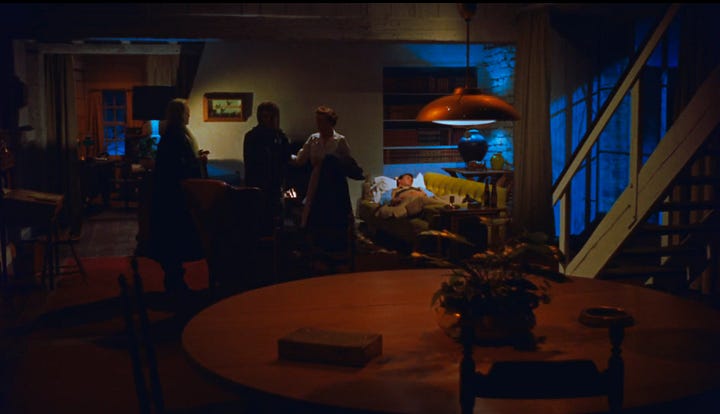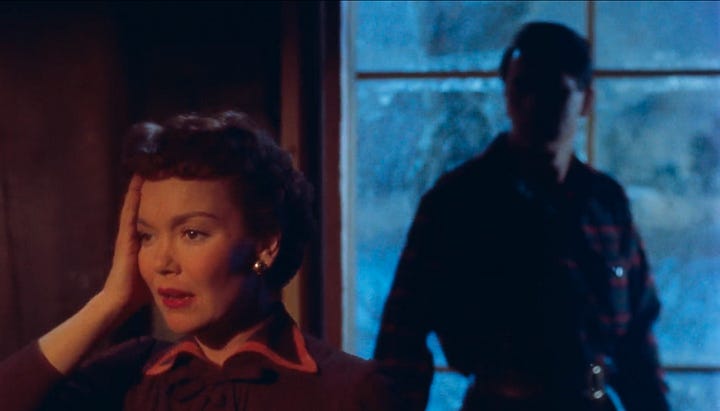Colour as Character Emotion in ALL THAT HEAVEN ALLOWS
a brief look at what four colour changes tell us about characters' shifting emotions
All That Heaven Allows uses a lot of reds and blues; sometimes shots are ‘washed’ in colour, and sometimes red and blue are used for strong contrast within shots:




Sometimes colour drastically shift in the middle of shots, whether through ‘practical’ lighting manipulation or chemical treatment of the film in post — this kind of drastic change is seen in our first and last examples.
1. Christmas Cheer and Isolation: group scene
As the camera repositions so Cary (Jane Wyman) is shown in the TV screen, the red bow blocks Kay out. Cary is surrounded, but alone.
As Cary looks at her reflection and feels isolated, the colour drastically shifts from warm reds to cold blues. The shift is unsubtle, as befits a melodrama.
2. Christmas Cheer and Isolation: solo scene



Jane decorates her tree in a warm, red room. She hears a noise outside, and looks out at the cold, blue-washed winter.
When the camera turns to see her looking out the window, the contrast between reds and blues show her conflicted state; yes she’s warm and happy (literally and figuratively), but she’s also just been reminded she’s alone and yearning for the companionship society denies her.
3. Seasons Change, Characters Contrast
The red tree stark against a bright blue sky losing its leaves is beautiful and evocative, but also clearly tells us ‘time has past.’
What’s also interesting to note is the character contrast: Cary comes from Frame Left wearing a cool beige coat before the camera tilts up. When the camera comes back down, Sara (Agnes Moorehead) comes from Frame Right, wearing a bolder, warm coat.
The edit jumps inside to show Cary ‘split’ in the cold, blue-black reflection of the piano, before hearing a knock and getting up. By the time Sara breezes in, all red lipstick and orange coat, we’re already mentally prepared for these two characters to be completely at odds, emotionally.
4. An Emotional Roller Coaster
This scene at the doctor’s office is warmer, but for a picture which uses colours so starkly, it’s almost ‘neutral.’ But as the doctors’ advice gets personal and hits home, check the colour shift at 0:25-0:28 - it’s a bit discombobulating, but that’s exactly the effect it’s meant to have, as Cary grapples with the waves of feelings crashing over her.
Takeaways
One thing about melodrama: you don't have to be subtle about much! Douglas Sirk milks blues and reds and colour shifts for all they’re worth in this gorgeous, emotional depiction of exterior social forces and a woman’s inner turmoil.

